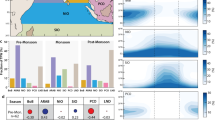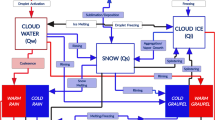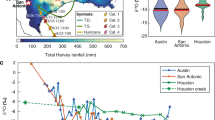Abstract
Tropical and midlatitude precipitation is fundamentally of two types, spatially limited and high-intensity convective or widespread and lower-intensity stratiform, owing to differences in vertical air motions and microphysical processes governing rain formation. These processes are difficult to observe or model and precipitation partitioning into rain types is critical for understanding how the water cycle responds to changes in climate. Here, we combine two independent data sets—convective and stratiform precipitation fractions, derived from the Tropical Rainfall Measuring Mission satellite or synoptic cloud observations, and stable isotope and tritium compositions of surface precipitation, derived from a global network—to show that isotope ratios reflect rain type proportions and are negatively correlated with stratiform fractions. Condensation and riming associated with boundary layer moisture produces higher isotope ratios in convective rain, along with higher tritium when riming in deep convection occurs with entrained air at higher altitudes. On the basis of our data, stable isotope ratios can be used to monitor changes in the character of precipitation in response to periodic variability or changes in climate. Our results also provide observational constraints for an improved simulation of convection in climate models and a better understanding of isotope variations in proxy archives, such as speleothems and tropical ice.
This is a preview of subscription content, access via your institution
Access options
Subscribe to this journal
Receive 12 print issues and online access
$259.00 per year
only $21.58 per issue
Buy this article
- Purchase on Springer Link
- Instant access to full article PDF
Prices may be subject to local taxes which are calculated during checkout




Similar content being viewed by others
References
Dansgaard, W. The abundance of O18 in atmospheric water and water vapour. Tellus 5, 461–469 (1953).
Dansgaard, W. Stable isotopes in precipitation. Tellus 16, 436–468 (1964).
Gedzelman, S. D. & Lawrence, J. R. The isotopic composition of cyclonic precipitation. J. Appl. Meteorol. 21, 1385–1404 (1982).
Gat, J. R. Oxygen and hydrogen isotopes in the hydrologic cycle. Annu. Rev. Earth Planet. Sci. 24, 225–262 (1996).
Risi, C. et al. Evolution of the stable water isotopic composition of the rain sampled along Sahelian squall lines. Q. J. R. Meteorol. Soc. 136, 227–242 (2010).
Kurita, N. et al. Intraseasonal isotopic variation associated with the Madden-Julian Oscillation. J. Geophys. Res. 116, D24101 (2011).
Gao, J. et al. What controls precipitation δ18O in the southern Tibetan Plateau at seasonal and intra-seasonal scales? A case study at Lhasa and Nyalam. Tellus B 65, 21043–21055 (2013).
Coplen, T. B. et al. Categorisation of northern California rainfall for periods with and without a radar brightband using stable isotopes and a novel automated precipitation collector. Tellus B 67, 28574 (2015).
Jouzel, J. Treatise on Geochemistry Vol. 5, 2nd edn, 213–256 (Elsevier, 2014).
Gedzelman, S. D. & Arnold, R. Modeling the isotopic composition of precipitation. J. Geophys. Res. 99, 10455–10471 (1994).
Kurita, N. Water isotopic variability in response to mesoscale convective system over the tropical ocean. J. Geophys. Res. 118, 1–15 (2013).
Sturm, C., Zhang, Q. & Noone, D. An introduction to stable water isotopes in climate models: benefits of forward proxy modelling for paleoclimatology. Clim. Past 6, 115–129 (2010).
Sutanto, S. J. et al. Atmospheric processes governing the changes in water isotopologues during ENSO events from model and satellite measurements. J. Geophys. Res. 120, 6712–6729 (2015).
Aggarwal, P. K. et al. New capabilities for studies using isotopes in the water cycle. Eos Trans. AGU 88, 537–538 (2007).
Moerman, J. W. et al. Diurnal to interannual rainfall δ18O variations in northern Borneo driven by regional hydrology. Earth Planet. Sci. Lett. 369, 108–119 (2013).
Fudeyasu, H. et al. Effects of large-scale moisture transport and mesoscale processes on precipitation isotope ratios observed at Sumatera, Indonesia. J. Meteorol. Soc. Jpn 89, 49–59 (2011).
Aggarwal, P. K. et al. Stable isotopes in global precipitation: a unified interpretation based on atmospheric moisture residence time. Geophys. Res. Lett. 39, L11705 (2012).
Houze, R. A. Jr Stratiform precipitation in regions of convection: a meteorological paradox? Bull. Am. Meteorol. Soc. 78, 2179–2196 (1997).
Houze, R. A. Jr Cloud Dynamics (International Geophysics Series 104, Academic, 2014).
Houze, R. A. Jr Structures of atmospheric precipitation systems: a global survey. Radio Sci. 16, 671–689 (1981).
Schumacher, C. & Houze, R. A. Jr Stratiform rain in the tropics as seen by the TRMM precipitation radar. J. Clim. 16, 1739–1756 (2003).
Stith, J. L. et al. Microphysical observations of tropical clouds. J. Appl. Meteorol. 41, 97–117 (2002).
Steiner, M. & Smith, J. A. Convective versus stratiform rainfall: an ice-microphysical and kinematic conceptual model. Atmos. Res. 47, 317–326 (1998).
Berg, P. et al. Strong increase in convective precipitation in response to higher temperatures. Nature Geosci. 6, 181–185 (2013).
Prein, F. et al. A review on regional convection-permitting climate modeling: demonstrations, prospects, and challenges. Rev. Geophys. 53, 323–361 (2015).
Liu, C. et al. A cloud and precipitation feature database from nine years of TRMM observations. J. Appl. Meteorol. Clim. 47, 2712–2728 (2008).
Funk, A., Schumacher, C. & Awaka, J. Analysis of rain classifications over the tropics by version 7 of the TRMM PR 2A23 algorithm. J. Meteorol. Soc. Jpn 91, 257–272 (2013).
Ehhalt, D. H., Rohrer, F. & Fried, A. Vertical profiles of HDO/H2O in the troposphere. J. Geophys. Res. 110, 7351–7366 (2005).
Bolin, B. On the use of tritium as a tracer for water in nature. Proc. Second United Nations Intl. Conf. Peaceful Uses of Atomic Energy Vol. 18, 336–343 (United Nations, 1959).
Nelson, J. Theory of isotopic fractionation on facetted ice crystals. Atmos. Chem. Phys. 11, 11351–11360 (2011).
Knight, C. A. et al. Radial and tangential variation of deuterium in hailstones. J. Atmos. Sci. 32, 1990–2000 (1975).
Zipser, E. J. et al. Where are the most intense thunderstorms on Earth? Bull. Am. Meteorol. Soc. 87, 1057–1071 (2006).
Romatschke, U. & Houze, R. A. Jr Characteristics of precipitating convective systems in the South Asian monsoon. J. Hydrometeorol. 12, 3–26 (2011).
Ehhalt, D. H. Vertical profiles and transport of HTO in the troposphere. J. Geophys. Res. 76, 7351–7367 (1971).
Liu, C. & Zipser, E. J. The global distribution of largest, deepest, and most intense precipitation systems. Geophys. Res. Lett. 42, 3561–3595 (2015).
Parker, M. D. & Johnson, R. H. Organizational modes of midlatitude mesoscale convective systems. Mon. Weath. Rev. 128, 3413–3436 (2000).
Trenberth, K. E. & Caron, J. M. The Southern Oscillation revisited: sea level pressures, surface temperatures, and precipitation. J. Clim. 13, 4358–4365 (2000).
Hartmann, D. L. et al. in Climate Change 2013: The Physical Science Basis (eds Stocker, T. F. et al.) Ch. 2 (IPCC, Cambridge Univ. Press, 2013).
Westra, S. et al. Future changes to the intensity and frequency of short-duration extreme rainfall. Rev. Geophys. 52, 522–555 (2014).
Houze, R. A. Jr Observed structure of mesoscale convective systems and implications for large-scale heating. Q. J. R. Meteorol. Soc. 115, 425–461 (1989).
Dayem, K. E. et al. Lessons learned from oxygen isotopes in modern precipitation applied to interpretation of speleothem records of paleoclimate from eastern Asia. Earth Planet. Sci. Lett. 295, 219–230 (2010).
Acknowledgements
We thank E. Izewski of IAEA for assistance with graphic illustrations.
Author information
Authors and Affiliations
Contributions
P.K.A. initiated the project and wrote the paper; U.R., D.B., C.S. and A.F. provided TRMM data; L.A.-A. processed isotope and related data; P.B. contributed cloud-based stratiform fractions; all authors contributed to data evaluation and commented on the manuscript.
Corresponding author
Ethics declarations
Competing interests
The authors declare no competing financial interests.
Rights and permissions
About this article
Cite this article
Aggarwal, P., Romatschke, U., Araguas-Araguas, L. et al. Proportions of convective and stratiform precipitation revealed in water isotope ratios. Nature Geosci 9, 624–629 (2016). https://doi.org/10.1038/ngeo2739
Received:
Accepted:
Published:
Issue Date:
DOI: https://doi.org/10.1038/ngeo2739
This article is cited by
-
Triple oxygen isotope compositions reveal transitions in the moisture source of West China Autumn Precipitation
Communications Earth & Environment (2024)
-
Isotopic signals of different rainfall types revealed by intra-event rainfall analysis
Theoretical and Applied Climatology (2024)
-
Global observational coverage of onshore oil and gas methane sources with TROPOMI
Scientific Reports (2023)
-
Dynamic and thermodynamic influences on precipitation in Northeast Mexico on orbital to millennial timescales
Nature Communications (2023)
-
Sources of water vapor and their effects on water isotopes in precipitation in the Indian monsoon region: a model-based assessment
Scientific Reports (2023)



